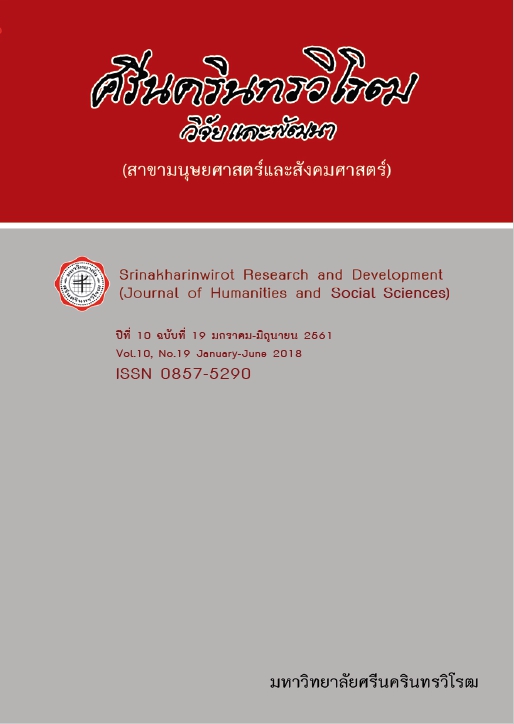ความต้องการมีบุตรในอนาคต: หลักฐานเชิงประจักษ์จากสตรีที่สมรสในประเทศไทย (FUTURE DESIRE FOR CHILDREN: EMPIRICAL EVIDENCES FROM MARRIED WOMEN IN THAILAND)
Keywords:
สตรีที่สมรส, ความต้องการมีบุตร, Desire for Children, Married WomenAbstract
This study aimed to examine situation and patterns of desire for children in the future and test association between characteristic factors and desire for children among married women in Thailand. Data were drawn from the 2012 Multiple Indicator Cluster Survey (MICS4) which was conducted by the National Statistical Office of Thailand. The total sample size is 15,661 participants and confined to married women in reproductive-age (age 15-49). This data were analyzed by using descriptive statistics and analysis technique in Cross-tabulation and Chi-square test. The overall situation showed that only 18.8 percent of married women expressed desire for children in the future, with increased desire among teenage women aged 15–19 (44.1 percent). Chi-square analysis result revealed that factors had statistically significant associated with desire for children in the future included age, age at first marriage, current pregnancy, loss of child experience, number of children still living, region, wealth status of household, and education. In addition, the results of patterns of desire for children in the future indicated that married women aged 25–29 had the highest proportion of desire for first child and second child (74.9 percent and 50.5 percent respectively), and married women aged 20–24 had the highest proportion of desire for third child and fourth (or more) child (16.8 percent and 9.8 percent respectively).
Downloads
References
[2] สำนักงานสถิติแห่งชาติ. (2553). การสำรวจอนามัยการเจริญพันธุ์ พ.ศ. 2552. สืบค้นเมื่อ 1 เมษายน 2559,จาก https://service.nso.go.th/nso/nsopublish/themes/files/fertility/fertilityFull.pdf
[3] นิพนธ์ เทพวัลย์. (2541). ประชากรศาสตร์. กรุงเทพฯ: ไทยวัฒนาพานิช.
[4] เดลินิวส์. (2557, 1 กรกฎาคม). ชี้เด็กเกิดน้อยลง หวั่นขาดแรงงาน. สืบค้นเมื่อ 1 เมษายน 2559, จาก https://www.dailynews.co.th/politics/249265
[5] ปัทมา ว่าพัฒนวงศ์; และ ปราโมทย์ ประสาทกุล. (2549). ประชากรไทยในอนาคต. สถาบันวิจัยประชากรและสังคม มหาวิทยาลัยมหิดล. สืบค้นเมื่อ 1 เมษายน 2559, จาก https://www.ipsr.mahidol.ac.th/IPSR/AnnualConference/ConferenceII/Article/Article02.htm
[6] วาสนา อิ่มเอม. (2557, 12 ธันวาคม). การเปลี่ยนแปลงโครงสร้างประชากร: ไทยกับประเทศอาเซียน. ใน เอกสารนำเสนอในงานประชุมวิชาการ เรื่อง การเปลี่ยนแปลงโครงสร้างประชากรกับอนาคตการพัฒนาประเทศ. หน้า 6-16. กรุงเทพฯ: โรงแรมเซ็นทารา แกรนด์ แอท เซ็นทรัลเวิลด์.
[7] สำนักงานคณะกรรมการพัฒนาการเศรษฐกิจและสังคมแห่งชาติ. (2555). แผนประชากรในช่วงแผนพัฒนา เศรษฐกิจและสังคมแห่งชาติ ฉบับที่ 11 (พ.ศ. 2555-2559). สำนักนายกรัฐมนตรี. สืบค้นเมื่อ 1 เมษายน 2559, จาก https://artculture.cmu.ac.th/images/uploadfile/depfile-150910140608.%E0%B8%A8
[8] Sikder, U. K. (2015, June-August). Empirical test of the Caldwell’s fertility theory of intergenerational wealth flows in India: evidence from National Family Health Survey Data. American International Journal of Research in Humanities. Arts and Social Sciences. 11(1): 77-80.
[9] Becker, G. S. (1960). Demographic and economic change in developed countries: Columbia University Press.
[10] Ross, J. L., Blangero, J., Goldstein, M. C., & Schuler, S. (1986). Proximate determinants of fertility in the Kathmandu Valley, Nepal: an anthropological case study. Journal of Biosocial Science, 18(2): 179-196.
[11] Fosu, M. O., Nyarko, I. P. R., & Anokye, M. (2013). The desire for last birth among Ghanaian women: The determinants. Research on Humanities and Social Sciences. 3(2): 122-129.
[12] สำนักงานสถิติแห่งชาติ. (2556). รายงานฉบับสมบูรณ์ การสำรวจสถานการณ์เด็กและสตรีในประเทศไทย พ.ศ. 2555. สืบค้นเมื่อ 1 เมษายน 2559, จาก https://service.nso.go.th/nso/nsopublish /themes/files/child-womenRep55.pdf
[13] วิทยา ถิฐาพันธ์. (2559). อายุของแม่กับการตั้งครรภ์. ภาควิชาสูติศาสตร์-นรีเวชวิทยา คณะแพทยศาสตร์ ศิริราชพยาบาล. สืบค้นเมื่อ 1 เมษายน 2559, จาก https://www.si.mahidol.ac.th/th/department /obstretrics_gynecology/dept_article_detail.asp?a_id=509
[14] อำนวย กาจีนะ. (2557, 21 พฤษภาคม). เด็กไทยเกิดใหม่น้อยลงแต่ยอดแม่วัยใสยังน่าห่วง. ไทยรัฐออนไลน์. สืบค้นเมื่อ 1 เมษายน 2559, จาก https://www.thairath.co.th/content/424172
[15] ฐิตินันท์ ผิวนิล. (2558, 4 กรกฎาคม). การตั้งครรภ์ในวัยรุ่นกับภาวะทารกแรกเกิดน้ำหนักตัวน้อย: การวิเคราะห์ข้อมูลสูติบัตรจังหวัดเพชรบุรีและประจวบคีรีขันธ์. ใน เอกสารการประชุมวิชาการระดับชาติ ราชภัฏเพชรบุรีวิจัยเพื่อแผ่นดินไทย ครั้งที่ 5. หน้า 337-344. เพชรบุรี: มหาวิทยาลัยราชภัฏเพชรบุรี.
[16] ศิริกุล อิศรานุรักษ์. (2549). ทารกน้ำหนักแรกเกิดน้อย: ปัญหาสุขภาพคนไทยที่ยังแก้ไม่ตก. วารสาร สาธารณสุขและการพัฒนา. 4(1): 67-79.
[17] อภิชาติ จำรัสฤทธิรงค์; และคณะ. (2549). ผลกระทบของการเสียชีวิตของบุตรต่อความมั่นคงของชีวิตสมรสของคนไทย. สืบค้นเมื่อ 1 เมษายน 2559, จาก https://www.ipsr.mahidol.ac.th/IPSR/Annual Conference/ConferenceII/Article/Download/Article10.pdf
[18] สันทัด เสริมศรี. (2541). ประชากรศาสตร์ทางสังคม. กรุงเทพฯ: สามเจริญพาณิช.
[19] สมยศ ทุ่งหว้า. (2543) ระบบสังคมเกษตร: ข้อเสนอเชิงแนวคิดที่ได้จากการวิจัยในภาคใต้. สืบค้นเมื่อ 22 กรกฎาคม 2559, จาก https://www.mcc.cmu.ac.th/Seminar/pdf/671.pdf
[20] อภิชาติ จำรัสฤทธิรงค์; และ อรทัย หรูเจริญพรพานิช. (2550). Sex and the City. สืบค้นเมื่อ 22 กรกฎาคม 2559, จาก https://www.ipsr.mahidol.ac.th/ipsr/annualconference/conferenceiii/Articles/ Article07.htm
[21] ฝ่ายวิจัยและศูนย์สารสนเทศทางประชากรศาสตร์. (2551). แนวคิดทฤษฎีที่เกี่ยวข้องกับภาวะเจริญพันธุ์. สืบค้นเมื่อ 22 กรกฎาคม 2559, จาก https://www.cps.chula.ac.th/cps/research_division/ theory/t_birth.html
[22] Shah, N. M., Shah, M. A., & Radovanovic, Z. (1998). Patterns of desired fertility and contraceptive use in Kuwait. International Family Planning Perspectives. 24(3): 133-138.
[23] Livingston, G. (2015). Childlessness falls, family size grows among highly educationed women. Retrieved May 6, 2016, from https://www.pewsocialtrends.org/files/2015/05/2015-05-07_children-ever-born_FINAL.pdf
[24] จงจิตต์ ฤทธิรงค์; และคณะ. (2557, 1 กรกฎาคม). สถานเลี้ยงเด็กช่วยให้คนมีบุตรมากขึ้นจริงหรือ. ใน เอกสารการประชุมวิชาการระดับชาติครั้งที่ 10 ประชากรและสังคม 2557. หน้า 99-120. กรุงเทพฯ: โรงแรมเอเชีย.
Downloads
Published
How to Cite
Issue
Section
License
Srinakharinwirot Research and Development Journal of Humanities and Social Sciences is licensed Under a Creative Commons Attribution-NonCommercial-NoDerivs 4.0 International (CC-BY-NC-ND 4.0) License, Unless Otherwise Stated. Please Read Journal Policies Page for More Information on Open Access, Copyright and Permissions.



